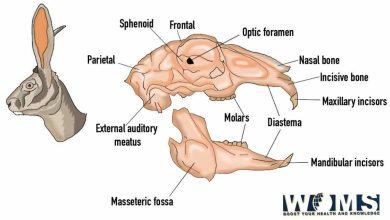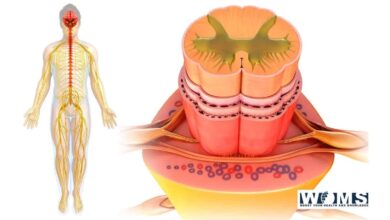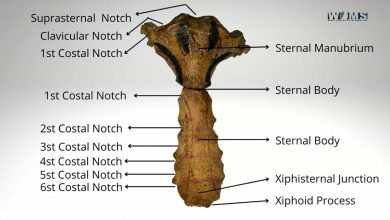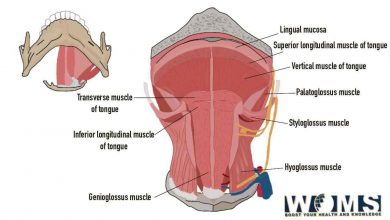Clavicle Bone
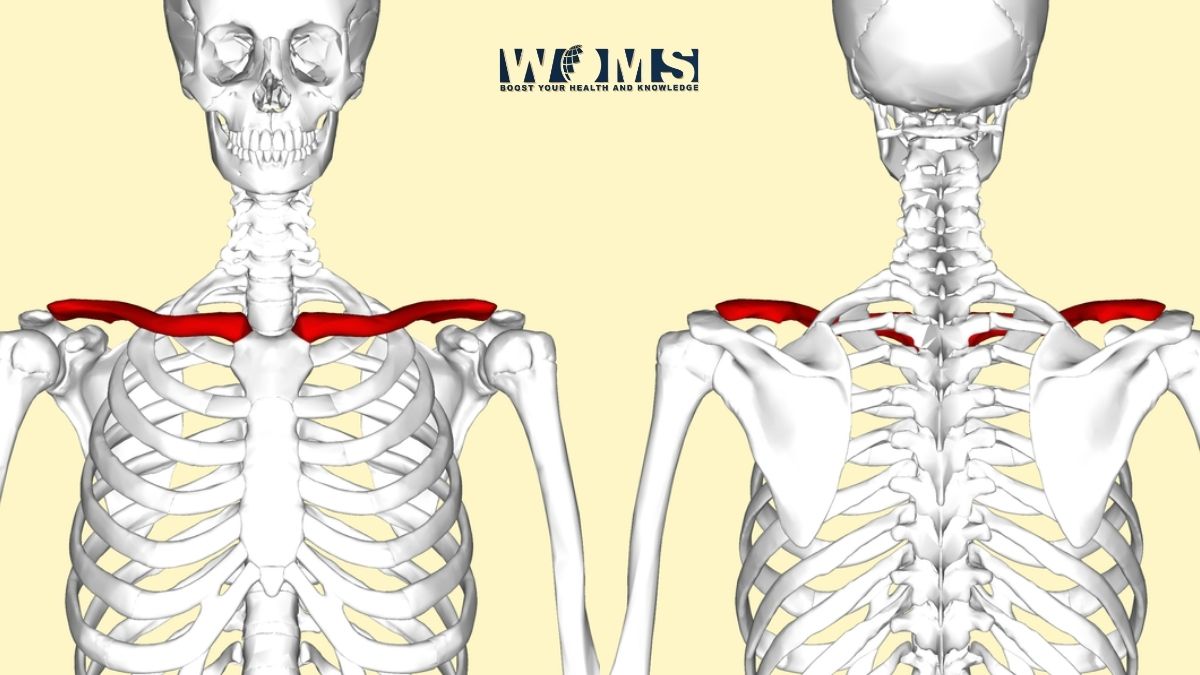
A clavicle or collarbone is an S-shaped, long bone in a slender form. It is a bony framework joining the sternum and glenohumeral joint.
There are two clavicle bones, one on the right and the other on the left side. It lies horizontally to the body axis. The location of this bone is visible among the people who have less fat in this region. It creates a prominent bulge in the skin due to its bony origin.
The clavicle plays a main role in the skeletal system forming the shoulder girdle. In addition, it acts as a junction or brace to transfer the loads from the upper limbs to the axial skeleton.
The clavicle bone is associated with several bony structures and musculature to work in the junction. There are also multiple ligaments and joints to connect the clavicle with other bones of the skeletal system.


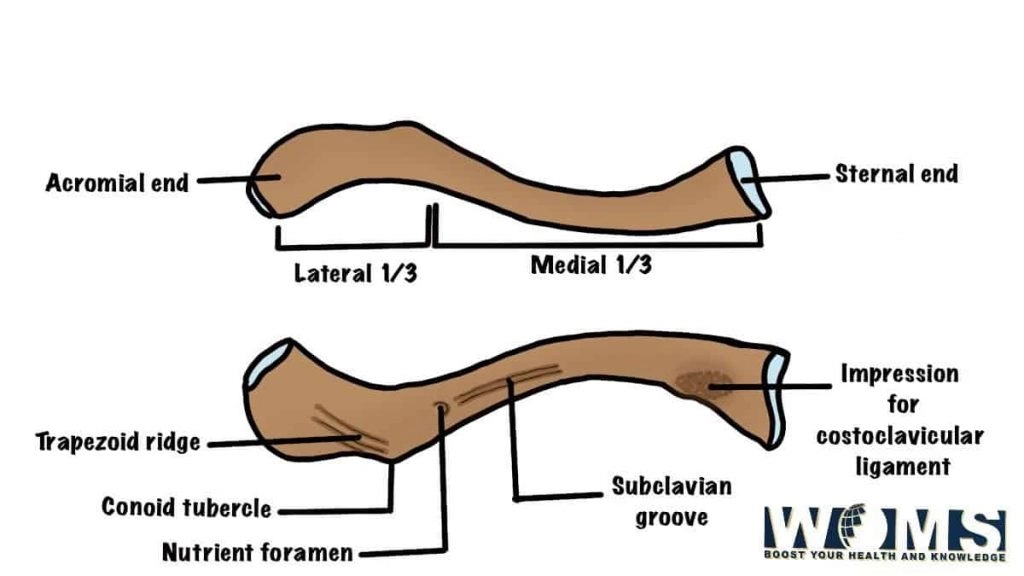
Physical properties of the clavicle:
- The clavicle is a long bone with two ends and a shaft.
- The shaft of the clavicle is divided into medial two-thirds as well as lateral one-third parts.
- The lateral-one third part consists of two borders: anterior border(concave forwards) and posterior border(convex backward)
- The lateral one-third part also consists of two surfaces: the superior surface which is subcutaneous and the inferior surface which presents a trapezoid ridge as well as a conoid tubercle.
- The medial two-thirds consists of four surfaces: anterior, posterior, superior, and inferior surfaces. The inferior surface at its lateral half consists of a subclavian groove where lies the nutrient foramen.
- There are two ends of the clavicle bone. One is the sternal or medial end containing a larger facet. Another is an acromial or lateral end to articulate with the acromion of the scapula bone posteriorly.
- There are three arteries that supply blood to the clavicle. suprascapular artery, thoracoacromial artery, and internal thoracic artery.
Functions of the clavicular bone in the human body
The clavicle is a crank-shaped cantilever that carries the scapula. Therefore, it enables the upper limb to swing freely away from the trunk.
Further, it helps in transmitting the weight from the upper limbs to the axial skeleton acting as the only bridge between the upper limbs and the axial skeleton. There are many important structures that go under the clavicle. For example, arteries veins, and brachial plexus.
The functions of the clavicle can be listed as follows;
- The Clavicle bone helps to protect the neurovascular structures like the brachial plexus, subclavian artery, and vein posteriorly.
- Clavicle bone also helps the scapula to glide smoothly along the posterior wall.
- Clavicle bone transmits the physiologic loads from the limbs to the whole skeleton.
- The clavicle bone is not a part of a larger support system. But, its attachments offer an enhanced function with a greater range of motion for the upper limbs.
Also Read: Supracondylar Fracture of Humerus
Articulation points of the clavicle bone
The clavicle is connected to different bones through several joints. There are several bones associated with the clavicle to work in the junction.
Clavicle bone forms diarthrosis type of articulation. In this type, opposing ends of the two bones are covered by hyaline cartilage separated by space. This is also known as the double plane joint.
There are two main joints that connect the clavicle heads (sternal and acromial) with the scapula and sternum.
- Acromioclavicular joint – joint between the acromial or lateral end of clavicle and acromion of scapula
- Sternoclavicular joint – the joint between the sternal or medial end of the clavicle and the manubrium of the sternum
Acromioclavicular joint
The first articulation of the clavicle is the acromioclavicular joint. It connects the clavicle’s lateral end and the scapula bone’s acromion.
This kind of joint allows a slight gliding movement around the shoulder region. It is also a kind of synovial joint. The end of both bones is covered by articular cartilage with intra-articular synovium.
This acromioclavicular joint offers the following functions:
- It offers an additional rotation to the scapula around the thorax.
- This joint also allows for the adjustment of the scapula to follow the changing shapes of the thorax when the arm moves.
- It allows transferring of the forces from the upper extremities to the clavicle bone
Sternoclavicular joint
The other joint in which the clavicle forms with the manubrium of the sternum are the sternoclavicular joint. This synovial joint connects the clavicle along with the scapula to the axial skeleton.
It offers only a limited, but a variety of movement to the arm. These movements include protraction and retraction, elevation and depression, and slight rotational movement.
The sternoclavicular joint is not only a simple synovial joint but contains a fibrocartilage joint disk. It enhances the joint curvature and contact with the joint surfaces. This disk functions to prevent medial displacement of the clavicle.
The sternoclavicular joint offers three kinds of movement in this area.
- Movement in sagittal plane: anterior and posterior rotational motion
- Movement in the frontal plane: elevation and depression
- Movement in transverse plane: protraction and retraction
Muscular attachments of the clavicle bone

- On the superior surface of the clavicle, there are four main muscular attachments.
- Medially it has two muscle attachments. Namely, the sternocleidomastoid muscle posteriorly and the pectoralis major muscle anteriorly.
- Laterally also it has two attachments. The trapezius muscle posteriorly and deltoid muscle anteriorly.
- Similarly, on the inferior surface clavicle has attachments for muscles.
- Anteriorly there is attachment to the pectoralis major muscle clavicular head throughout its medial three-fifth.
- Posteriorly there is a small area for the attachment of the sternohyoid muscle.
- Along the inferior side of the intermediate two-fifths, there is a groove for the attachment of the subclavius
- More laterally, on the inferior surface of the clavicle bone, there is an attachment for deltoid. And posterior to that it has an attachment to the trapezius.
Important structures associated with the clavicle
More laterally the middle three-fifths of the clavicle bone curves in front of the trunks and divisions of the brachial plexus. Also, the third part of the subclavian artery lies below it.
There are few structures immediately behind and above the medial three-fifths. Namely, they are
- The thoracic-cervical trunk branches
- The suprascapular vessels
- The transverse cervical vessels.
Although these structures are closely associated with the clavicular bone, they are rarely getting into damaged in a fracture.
Clinical importance
The clavicle is a bony landmark to several other clinical points. In this way, the clavicle is considered an important clinical point for several structures. Let us have a look at the clinical points of the clavicle.
- The midclavicular line is a landmark for locating cardiac apex beats and appreciating the liver size. In addition, it also tells about the position of the gallbladder.
- Clavicle fractures account for about 10% of all bony fractures. It is the most common type of fracture. The fracture may occur from falling directly on the shoulder or any kind of trauma. Movements around the clavicle may get disrupted.
- The acromioclavicular joint dislocation may occur in contact sports. The injury severity increases with the type of injury and the gap between the articulating surfaces.
- Acromioclavicular joint osteoarthritis may occur due to degenerative, septic, or inflammatory arthritis. It is a debilitating disorder for the patients to do their daily life activities.
- The sternoclavicular joint injuries are less common. But, anterior dislocation may occur at this joint.
Clavicle bone fracture
Clavicular bone fracture is mostly due to falls on an outstretched hand. The most common site of fracture is the middle of the shaft.
A person with a fracture of the clavicle bone always presents by supporting their fractured sidearm with the other arm. In this, the most appropriate measures of management are with immobilizing with a splint. Whereas surgery is not for treatment since it spontaneously heals over months of resting.
However, it is important to check if the movements of the upper limbs seem to be impair or not. Because a lot of important neurovascular structures are in close association with the clavicle bone.
Symptoms
A person suffering from a clavicle bone fracture may experience great pain while moving their shoulder or arm. There might be swelling or tenderness in the fractured area. Similarly, the shoulder might sag in the anterior or interior direction.
Treatment
The treatment of the clavicle bone fracture can be surgical or non-surgical, depending on the fracture’s condition.
The non-surgical method is applicable if the fractures still line up correctly. In this method, a simple arm sling keeps the pieces in line and heals naturally in course of time.
The surgical method is applicable if the fracture pieces are not in alignment.
In this method, the clavicle fracture pieces are screwed to a metal plate which helps them to keep it in a place and helps to heal.
FAQs:
Which bone is called the beauty bone and why?
The clavicle is called the beauty bone of the body and it is called beauty bone due to its prominent location in our body which gives alignment to a person’s body.
Why clavicle is the weakest bone?
The clavicle is the weakest bone because it is a thin bone and runs horizontally between the breastbone and shoulder blade. Since is the weakest bone it is more prone to fractures.
Which is the weakest part of the clavicle?
The weakest part of the clavicle is the middle third segment of the clavicle and this part is also more prone to fractures.

